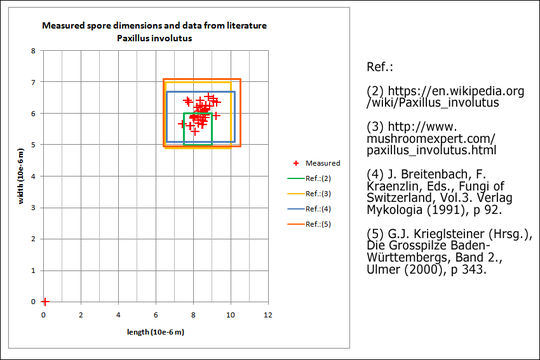Sivun pulkkosieni kuva

Kuvaus:
Slo.: navadna podvihanka - syn.: Agaricus involutus Batsch, Omphalia involuta (Batsch) Gray - Habitat: moderately inclined mountain slope, southeast aspect; mixed wood edge, under Ostrya carpinifolia and Picea abies; calcareous ground; dry place, mostly in shade; partly protected from direct rain by tree canopies; average precipitations ~ 3.000 mm/year, average temperature 7-9 deg C, elevation 640 m (2.100 feet), alpine phytogeographical region. Substratum: in moss over forest soil, also on a thin moss layer over rock. Comments: Paxillus involutus is widely distributed in Europe and America (also introduced in Australia and New Zeeland) and common fungus. Nevertheless, it is interesting from several aspects. It clearly has gills; however, they look strange (they divide and join irregularly). Sometimes they are near the stipe even similar to pores (not in this find). The fungus is definitely related to boletes (Polyporaceae). Its pore layer is easy to separate from the hut flesh like in boletes. Also, it can be infected by parasitic fungus Hypomyces chrysospermus, which normally attacks only boletes. Also DNA analyses (to some extent) confirmed this relation. The fungus is very variable and authors divide it into several species (or subspecies). However, the complete picture is yet unclear, or at least not generally accepted by the mycologists community. The second interesting thing relates to its edibility. It was considered a good comestible fungus until the midst of last century and widely eaten particularly in eastern European countries. It had been known only as causing light gastric upsets when eaten raw but safe if cooked. But in 1944 German mycologist Julius Schffer died after eating it in two weeks. This tragic and unexpected case started much of scientific interest for this fungus. Soon a Swiss physician found that the mushroom actually doesn't contain an unknown poisonous substance, but a certain antigen. This antigen can trigger (under a certain conditions) a violent autoimmune reaction in human body, which attacks its own red blood cells. Potentially fatal complications including acute renal failure, shock, and respiratory failure may result. There is no known antidote for poisoning. One can eat this fungus for years without any ill effects, but this autoimmune reaction can attack any time and without warning. 'Funny' enough, the last book about mushrooms, which had still recommended eating this species, was published in 1993. Description: Growing in groups of several fruitbodies and solitary; more than 20 pilei altogether; cap diameter 4.5 - 8 cm, pilei trama up to 10 mm thick, gills layer up to 3.5 mm thick; gills crowded, up to 130 gills per 3600 were counted; gills layer can be easily separated from trama; bruising brown-red when handled; cutis strong, easily pealing; stipes up to 6.5 cm long with diameter up to 16 mm; longitudinally fibrous, not hollow, tapering toward the base; picked mushrooms turn entirely to brown-reddish with time; smell mushroomy, on soil, quite strong; taste mild mushroomy; SP ochre-brown, oac817. Spores smooth with one guttule. Dimensions: (7.5) 7.8 - 8.9 (9.2) x (5.5) 5.6 - 6.4 (6.6) microns; Q = (1.2) 1.3 - 1.47 (1.5); N = 35, Me = 8.4 x 6 microns; Qe = 1.4. Olympus CH20, NEA 100x/1.25, magnification 1.000 x, oil in water; fresh material. AmScope MA500 digital camera. Herbarium: Mycotheca and lichen herbarium (LJU-Li) of Slovenian Forestry Institute, Vena pot 2, Ljubljana, Index Herbariorum LJF Ref.: (1) Personal communication (Ided by) Mr. Bojan Rot, www.gobenabovskem.si (2) https://en.wikipedia.org/wiki/Paxillus_involutus (accessed Sept. 22. 2017) (3) http://www.mushroomexpert.com/paxillus_involutus.html (accessed Sept. 22. 2017) (4) J. Breitenbach, F. Kraenzlin, Eds., Fungi of Switzerland, Vol.3. Verlag Mykologia (1991), p 92. (5) G.J. Krieglsteiner (Hrsg.), Die Grosspilze Baden-Wrttembergs, Band 2., Ulmer (2000), p 343.
Mukana seuraavilla sivuilla:
- Life
- Cellular
- Eukaryota (aitotumaiset)
- Opisthokonta
- Nucletmycea
- Fungi
- Dikarya
- Basidiomycota (Kantasienet)
- Agaricomycetes (Avokantaiset)
- Boletales
- Paxillaceae
- Paxillus (Pulkkosienet)
- Paxillus involutus (pulkkosieni)
Tämä kuva ei ole esillä missään kokoelmassa.
Lähdetiedot
- lisenssi
- cc-by-nc-sa-3.0
- tekijänoikeus
- 2017 Dr. Amadej Trnkoczy
- valokuvaaja
- Dr. Amadej Trnkoczy
- alkuperäinen
- alkuperäinen mediatiedosto
- käy lähteessä
- kumppanisivusto
- CalPhotos
- ID


